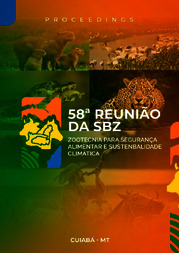Green matter productivity of elephant grass genotypes in different cuts.
Green matter productivity of elephant grass genotypes in different cuts.
Author(s): SANTOS, J. dos; SILVA, V. Q. R. da; TARDIN, F. D.; SOUZA, J. M. S. de
Summary: Abstract: In the search for high quality and quantity forage for animals, elephant grass (Pennisetum purpureum Schum.) stands out for being a perennial plant, which adapts to different locations and climates, and can be offered in the form of weeding, grazing, silage or hay. The productivity of this forage is linked to factors intrinsic to the plant and external factors, combined, one of these being the cutting season. In this way, the objective of this work was to evaluate the green matter productivity of different genotypes of elephant grass subjected to four cuts. The trial was conducted in the experimental area of Embrapa Agrossilvopastoril, located in the city of Sinop-MT, Brazil. Planting was done by vegetative propagation (stake), The implementation date was November 5, 2015, and after 90 days the uniformity cut of materials occurred. The productivities of twenty materials were evaluated, the BAGCE 1 - Elefante da Colômbia, BAGCE 3 - Três Rios, BAGCE 6 - Pusa Napier No 2, BAGCE 19 - Merkeron de Pinda, BAGCE 22 - Taiwan A-144, BAGCE 23 - Napier S.E.A., BAGCE 50, BAGCE 51, BAGCE 57 – Roxo, BAGCE 59, BAGCE 60 – Guaco, BAGCE 62 - Cuba-116, BAGCE 64 - King Grass, BAGCE 66 – Mineirão, BAGCE 69, BAGCE 91 - Pasto Panamá, BRS Capiaçu, BAGCE 38 - Cameroon – Piracicaba, Madeira, BRS Canará. Fertilization was carried out in accordance with recommendations for the crop. To estimate productivity, data from four cuts were used, the first being on July 26, 2016, the second on April 18, 2017, the third on December 12, 2017, and the fourth in May 21, 2018. The plants were cut approximately 10 cm from the ground and productivity was estimated in t ha-1. The collected data was subjected to an analysis of variance and by the Scott-Knott average test using the Genes program (2016). The analysis of variance showed that there was a significant difference between the behavior of the genotypes in the different cuts. It was possible to observe that the productivity of materials in cut 2 was below the productivity in other cuts, which may have been caused by the incidence of leafhoppers in accordance with the susceptibility of the materials. Based on the average test considering four cuts, it was possible to rank the materials, three stood out with better averages between cuts, the BAGCE 66 – Mineirão, BAGCE 64 - King Grass and BRS Capiaçu, with 66.89 t ha-1, 66.32 t ha-1 5.46 t ha-1, respectively, demonstrating productive potential and suitable for cultivation in the region. The materials with the lowest productivity were BAGCE 19 - Merkeron de Pinda, BAGCE 6 - Pusa Napier No 2, BAGCE 51 e BAGCE 3 - Três Rios, with average productivity of 34.21 t ha- 1, 33.49 t ha-1, 33.48 t ha-1 e 30.73 t ha-1, respectively, not being the most adapted materials to the region.
Publication year: 2024
Types of publication: Abstract in annals or event proceedings
Observation
Some of Embrapa's publications are published as ePub files. To read them, use or download one of the following free software options to your computer or mobile device. Android: Google Play Books; IOS: iBooks; Windows and Linux: Calibre.
Access other publications
Access the Agricultural Research Database (BDPA) to consult Embrapa's full library collection and records.
Visit Embrapa Bookstore to purchase books and other publications sold by Embrapa.

